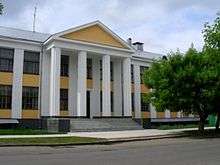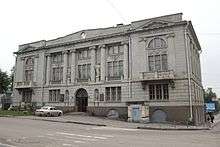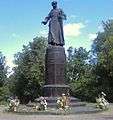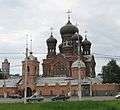Ivanovo
| Ivanovo (English) Иваново (Russian) | |
|---|---|
| - City[1] - | |
_2016.jpg) Revolution Square and city hall | |
.svg.png) Location of Ivanovo Oblast in Russia | |
 Ivanovo | |
|
| |
.svg.png) |
|
|
| |
| Administrative status (as of October 2011) | |
| Country | Russia |
| Federal subject | Ivanovo Oblast[1] |
| Administratively subordinated to | City of Ivanovo[2] |
| Administrative center of | Ivanovo Oblast,[1] Ivanovsky District,[1] City of Ivanovo |
| Municipal status (as of January 2005) | |
| Urban okrug | Ivanovo Urban Okrug[3] |
| Administrative center of | Ivanovo Urban Okrug,[3] Ivanovsky Municipal District[3] |
| Head | Alexander Fomin[4] |
| Statistics | |
| Area | 104.84 km2 (40.48 sq mi)[5] |
| Population (2010 Census) | 408,330 inhabitants[6] |
| - Rank in 2010 | 43rd |
| Density | 3,895/km2 (10,090/sq mi)[7] |
| Time zone | MSK (UTC+03:00)[8] |
| First mentioned | 1608[9] |
| City status since | 1871 |
| Previous names | Ivanovo-Voznesensk (until 1932) |
| Postal code(s)[10] | 24401 |
| Dialing code(s) | +7 4932 |
|
| |
| Ivanovo on Wikimedia Commons | |
Ivanovo (Russian: Иваново; IPA: [ɪˈvɑːnəvə]) is a city and the administrative center of Ivanovo Oblast, Russia, located 254 kilometers (158 mi) from Moscow and approximately 100 kilometers (62 mi) from Yaroslavl, Vladimir, and Kostroma. Population: 408,330 (2010 Census);[6] 431,721 (2002 Census);[11] 481,042 (1989 Census).[12]
Geography
The Uvod River, a tributary of the Klyazma, flows from north to south, dividing the city in to two halves. There are also two rivers in Ivanovo: the Talka and the Kharinka.
History
The city is first mentioned in 1561, when it was given to the Cherkassky princely family by Ivan IV, after the latter's marriage to Maria Cherkasskaya. However, the relevant document has since been lost.
The modern city was created by merging the old flax-processing village Ivanovo with the industrial Voznesensky Posad in 1871. Yakov Garelin—a patron of arts, historian, manufacturer, and public figure—is considered to be the founder of the city and its second head. Under his government, the city began to develop, industrialise, and grow.
Until 1932, the official name of the city was Ivanovo-Voznesensk. Because of its textile manufacturing industry, Ivanovo earned the sobriquet of the "Russian Manchester" during the 19th century.[13]
By the early 20th century, Ivanovo was competing with Łódź (also a part of the Russian Empire at that time) for the title of the primary textile production center of Europe. As the workers' living conditions were appalling, the strikes were frequent. One of these strikes (May 14-July 22, 1905) led to the first Russian revolution. According to the Soviet historiography,[14] the Ivanovo Soviet (created on May 28, 1905) was one of the first soviets in history. However, this statement is contested.
In 1937 the city opened the Interdom - a school for children of foreign Communists, including high learning.
In Ivanov the legendary air squadron (then - known as a Regiment) "Normandie-Niemen" began operations. By agreement between the Soviet government and the "Free French" government-in-exile in late 1942, a group of French pilots was sent to the Soviet Union. Construction of a new airport began on the northern outskirts of the city. The pilots were provided with decent housing, and 14 Yak-1 fighter aircraft. During 1943, the French fought alongside the Soviet Air Forces.
After the war, along with the continued textile industry in Ivanovo engineering and other industries developed.[15] In the 1960s, the city became the center of the Upper-Economic Council. The 1980s saw the accelerated pace of housing construction.
Since the beginning of the 21st century there has been declining production in Ivanovo. In the first decade of the century, a large number of enterprises were closed. The weaving factories BIM, BAT melange Plant and other smaller companies in the textile industry ceased to exist.
Administrative and municipal status
Ivanovo is the administrative center of the oblast[1] and, within the framework of administrative divisions, it also serves as the administrative center of Ivanovsky District,[1] even though it is not a part of it.[2] As an administrative division, it is incorporated separately as the City of Ivanovo—an administrative unit with the status equal to that of the districts.[2] As a municipal division, the City of Ivanovo is incorporated as Ivanovo Urban Okrug.[3]
Economy
Ivanovo has traditionally been called the textile capital of Russia. Since most textile workers are women, it has also been known as the "city of brides". Probably the most famous of the city's female natives was the postmodern French writer Nathalie Sarraute.
Transportation
Public transport is represented by trolleybuses, buses and taxis. The trolleybus system was opened on November 5, 1962. The first line ran from the Bagayeva area (now Victory Square) to the GZIP plant. The tram was operated from November 6, 1934 until June 1, 2008. According to Ivanov, the former Mayor Alexander Fomin: "Over the past 20 years, the number of vehicles in the city has increased by more than 10 times, while traffic is 5–7 times higher than that for which they were designed.
The system of urban bus services in Ivanovo-Voznesensk began on November 8, 1926. The bus park was originally located on the street Paris Commune. In the early 1960s, a new bus depot was built on Prospekt Tekstilchshiki. In the Soviet period, the operation of buses and coaches exercised Ivanovskoye passenger motor company (MTE) #1, and taxi station (Ivanovo MTE-2). Ivanovo MTE-1 closed in December 2007.
It is home to Ivanovo Severny, which is one of the largest military airlift bases in Russia. Civilian air services are provided at the Ivanovo Yuzhny Airport. Since 1896, there is a railway connection between Ivanovo and Moscow.[16]
Education

Ivanovo has several educational institutions: Ivanovo State University, Ivanovo State University of Chemistry and Technology, Ivanovo Medical Academy, Ivanovo Architectural Academy, and Ivanovo State Power University (ISPU).
Attractions

There are several objects of cultural heritage in Ivanovo. The center of the city boasts buildings of the period of constructionism built there in the 1920s – early 1930s. For historical reasons, Ivanovo-Voznesensk became the site of unique construction experiments carried out by both architects from Moscow and St. Petersburg, and local architects.[17] Among them are the buildings, like the Ship-house (1930), architect D. F. Fridman; the Horseshoe-house (1934), architect A. I. Panov; the Regional Bank building (1927), architect V. A. Vesnin; the Palace of Arts (1939), architect A. V. Vlasov; the Collective-house (1931), architect I. A. Golosov; the Ivanovo railway station (1934); Oblsovnarhoz-houses (1935), N. I. Kadnikov; and others.[18]
Many monuments are devoted to the revolutionary past of the city, such as the "Red Talka" memorial or numerous monuments to revolutionaries. The historical center of the city is notable mainly for the former houses of famous Ivanovites: the mansion houses of E. I. Gratchev (1774), I. N. Polushin (1904; here the Soviet government was first declared), K. D. Burkov, the Kuvayevs, the Gandurins, the Burlinis, etc. The industrial architecture, like the remaining textile manufactures of the 19th century, is also of interest.
Other notable sights include Schudrovskaya Palatka (17th century), the first brick civil building in Ivanovo, the Svyato-Vvedensky Monastery (architect P. Begen), the wooden Uspenskaya church (17th century), the mansion of A. Duringer (1910), and others.
The youth policy
History
According to historians, the youth policy in the city started in 1892, when the first Marxist society was formed. In 1919 the city Komsomol (Young Communist League) organization was established, soon this movement spread all over the region. By the beginning of the Great Patriotic War in 1941, Ivanovo regional Komsomol organization had already had over 100 thousand people. After the war the main objectives of the movements were to bring up and educate the working youth and to organize various activities. In 1970-1980s different circles and amateur theatres were functioning, and people’s universities were established.
In the 1980s, Ivanovo Oblast became one of the largest student centers of European Russia (7 institutes of higher education and 26 colleges with about 35 thousand students).
In the 1990s, the youth policy in Ivanovo was challenged, but remained and developed, due to the activity of initiative ivanovites. In 1992 the Department of youth affairs was established. The new youth policy was being formed. New legislature and programs were launched to encourage young families, youth employment, patriotic education and support. 53 clubs of young families and 28 military-patriotic organizations were formed. Since the beginning of the 2000s the complex youth and children’s policy has been pursued, through the legislative (like the regional law “Of the state support of youth and children’s social organizations) and grant support means.
Nowadays the Department of internal affairs of the Ivanovo region is responsible for the development of the youth policy of the region.
Development
There are almost 98 thousand young people in Ivanovo, i.e. each fourth citizen. It is one of the Russian students' centers, with 8 public and 5 private institutes of higher education, offering educational facilities both for Russian and foreign students. The city is the third largest one in the country after Moscow and the Moscow region, in terms of number of students per 10 000 citizens.
There are 18 military-patriotic clubs with about 550 young participants, 170 people are in charge of local history activities. More than 20 per cent of young citizens take part in the youth organizations’ activities, like “IMCA – Ivanovo”, Russian Youth Union, the “Novy Rubezh”, Ivanovo city pupils’ Duma, the “Shkolny Activ Goroda” (City school activists) and many others.
Annually the city holds the “Students’ spring” festival of students’ creativity. It’s the most popular event in cultural life of Ivanovo students, with the participation of all universities and institutes. Since 1997 the interregional festival of students “Maslenitsa” (“Pancake week”) is held. Yearly about 20 students’ teams from 6-8 regions take part in it.
Being concerned of the youth creativeness, the city government supports the development of facilities of students’ cultural, sporting and entertainment centers, as well as organizes regional sports competitions among students.
In order to encourage young scientists, each year the best students are given the grant of the governor, which is a good support for gifted researches. To increase the academic level of the youth, the contest of students’ and postgraduates’ researches was established. The papers should be devoted to the resolution of topical problems of the region. The best authors are given the award named after M. V. Frunze.
Ivanovo is a multinational city, more than 100 nationalities’ representatives live here. There are 16 ethnic and cultural autonomies, associations and centers.
Much attention is paid to the youth parliamentarism, which is developing within such structures, as the Youth Civic Council of the City Administration and Ivanovo city pupils’ Duma. The deputies of the latter participate in real elections campaigns in their schools, represents the schoolchildren’s interests to the municipal government, contribute to the development of youth initiatives, arrange socially topical activities, like the charity marathon “Ty nam nuzhen” (“We need you”) aimed at supporting children with disabilities. There are several opportunities for the talented youth as well, e.g. awards and grants from the Head of the city.
In 2012 schoolchildren of Ivanovo supported the city’s bid to the contest “The European Youth Capital 2015” and organized a flash mob and made large patchwork cloth. As a candidate city, Ivanovo is realizing a comprehensive program for the youth development, having invited professionals of the international level. One of the contest’s objective being to strengthen interaction between local communities and the European structures, Ivanovo is increasing cooperation with international partners and investors, in order to develop its infrastructure. The status of the European Youth Capital will give Ivanovo a chance to become a role model for Russian and European cities, ready for empowering the youth and renovating their local communities. Ivanovo is a youth and student center with great intellectual potential, where new ambitious ideas and projects are born and develop. Ivanovo of the future is a city which no one wants to leave, quite on the contrary. So far the municipal and regional administration with the young activists has decided to bid for the title of the European Youth capital 2015. The initiative has been welcomed by Prime-minister and President of Russia.
On July 4, 2012, the European Youth Forum has published a list of finalists for the title "European Capital of Youth 2015." The city of Ivanovo was one of the finalists of the city.
 Mikhail Frunze Monument
Mikhail Frunze Monument Ivanovo Industrial Paper Goods Factory
Ivanovo Industrial Paper Goods Factory Vvedensky monastery
Vvedensky monastery
Notable people
- Andrei Bubnov, Bolshevik politician
- Yelena Kruglova, swimmer
- Sergey Nechayev, revolutionary nihilist
- Nathalie Sarraute, writer
- Georgiy Shilov, mathematician
- Vladimir Tsybin, flautist and conductor
- Slava Zaitsev, designer
Twin towns and sister cities
Ivanovo is twinned with:
 Łódź, Poland (since 1992)[19]
Łódź, Poland (since 1992)[19] Plano, Texas, United States
Plano, Texas, United States Ayia Napa, Cyprus
Ayia Napa, Cyprus Staffordshire, United Kingdom
Staffordshire, United Kingdom Hanover, Germany
Hanover, Germany Khmelnytskyi, Ukraine
Khmelnytskyi, Ukraine Dzerzhinsky, Moscow Oblast, Russia
Dzerzhinsky, Moscow Oblast, Russia Kazan, Republic of Tatarstan, Russia
Kazan, Republic of Tatarstan, Russia Plovdiv, Bulgaria
Plovdiv, Bulgaria Kraljevo, Serbia
Kraljevo, Serbia Braga, Portugal
Braga, Portugal
See also
References
Notes
- 1 2 3 4 5 6 Law #145-OZ
- 1 2 3 Law #145-OZ stipulates that the borders of the administrative districts are identical to the borders of the municipal districts. The Law #40-OZ, which describes the borders and the composition of Ivanovsky District, does not list the city of Ivanovo as a part of that district.
- 1 2 3 4 Law #124-OZ
- ↑ Official website of the Administration of Ivanovo. Alexander Germanovich Fomin, Head of the City (Russian)
- ↑ Территория Иванова на сайте ивановской администрации
- 1 2 Russian Federal State Statistics Service (2011). "Всероссийская перепись населения 2010 года. Том 1" [2010 All-Russian Population Census, vol. 1]. Всероссийская перепись населения 2010 года (2010 All-Russia Population Census) (in Russian). Federal State Statistics Service. Retrieved June 29, 2012.
- ↑ The value of density was calculated automatically by dividing the 2010 Census population by the area specified in the infobox. Please note that this value may not be accurate as the area specified in the infobox does not necessarily correspond to the area of the entity proper or is reported for the same year as the population.
- ↑ Правительство Российской Федерации. Федеральный закон №107-ФЗ от 3 июня 2011 г. «Об исчислении времени», в ред. Федерального закона №271-ФЗ от 03 июля 2016 г. «О внесении изменений в Федеральный закон "Об исчислении времени"». Вступил в силу по истечении шестидесяти дней после дня официального опубликования (6 августа 2011 г.). Опубликован: "Российская газета", №120, 6 июня 2011 г. (Government of the Russian Federation. Federal Law #107-FZ of June 31, 2011 On Calculating Time, as amended by the Federal Law #271-FZ of July 03, 2016 On Amending Federal Law "On Calculating Time". Effective as of after sixty days following the day of the official publication.).
- ↑ Когда появилось Иваново (Russian)
- ↑ Почта России. Информационно-вычислительный центр ОАСУ РПО. (Russian Post). Поиск объектов почтовой связи (Postal Objects Search) (Russian)
- ↑ Russian Federal State Statistics Service (May 21, 2004). "Численность населения России, субъектов Российской Федерации в составе федеральных округов, районов, городских поселений, сельских населённых пунктов – районных центров и сельских населённых пунктов с населением 3 тысячи и более человек" [Population of Russia, Its Federal Districts, Federal Subjects, Districts, Urban Localities, Rural Localities—Administrative Centers, and Rural Localities with Population of Over 3,000] (XLS). Всероссийская перепись населения 2002 года [All-Russia Population Census of 2002] (in Russian). Retrieved August 9, 2014.
- ↑ Demoscope Weekly (1989). "Всесоюзная перепись населения 1989 г. Численность наличного населения союзных и автономных республик, автономных областей и округов, краёв, областей, районов, городских поселений и сёл-райцентров" [All Union Population Census of 1989: Present Population of Union and Autonomous Republics, Autonomous Oblasts and Okrugs, Krais, Oblasts, Districts, Urban Settlements, and Villages Serving as District Administrative Centers]. Всесоюзная перепись населения 1989 года [All-Union Population Census of 1989] (in Russian). Институт демографии Национального исследовательского университета: Высшая школа экономики [Institute of Demography at the National Research University: Higher School of Economics]. Retrieved August 9, 2014.
- ↑ Cookson, Roy (2002). A World of Manchesters. Casthermen Books. p. 111. ISBN 0-9542404-0-5.
- ↑ e.g., the Great Soviet Encyclopedia article "Soviets of Workers' Deputies"
- ↑ Глебов Ю. Ф., Лешуков Т. Н. Иваново. Путеводитель. — Ярославль: Верх.-Волж. кн. изд-во, 1981. — 256 с. — 50 000 экз. — ISBN , ББК 26.89 (2Р344—2)
- ↑ Train Station in Ivanovo (Russian)
- ↑ Mikhail Timofeyev. The Obscured Constructivism of IvanovoVoznesensk
- ↑ Ivanovo constructivism
- ↑ "Miasta partnerskie - Urząd Miasta Łodzi [via WaybackMachine.com]". City of Łódź (in Polish). Archived from the original on June 24, 2013. Retrieved 2013-07-21.
Further reading
- Mah, Alice. Industrial Ruination, Community, and Place: Landscapes and Legacies of Urban Decline (University of Toronto Press; 2012) 240 pages; comparative study of urban and industrial decline in Niagara Falls (Canada and the United States), Newcastle upon Tyne, Britain, and Ivanovo, Russia.
Sources
- Ивановская областная Дума. Закон №145-ОЗ от 14 декабря 2010 г. «Об административно-территориальном устройстве Ивановской области», в ред. Закона №2-ОЗ от 4 февраля 2015 г. «Об отдельных вопросах правового регулирования в сфере присвоения наименований географическим объектам и переименования географических объектов на территории Ивановской области». Вступил в силу через 10 дней после дня официального опубликования. Опубликован: "Собрание законодательства Ивановской области", №50(519), 30 декабря 2010 г. (Ivanovo Oblast Duma. Law #145-OZ of December 14, 2010 On the Administrative-Territorial Structure of Ivanovo Oblast, as amended by the Law #2-OZ of February 4, 2015 On Various Issues of the Legal Regulation in the Area of Assigning Names to Geographical Objects and Renaming the Geographical Objects on the Territory of Ivanovo Oblast. Effective as of the day which is 10 days after the official publication.).
- Законодательное Собрание Ивановской области. Закон №124-ОЗ от 29 сентября 2004 г. «О муниципальных районах и городских округах», в ред. Закона №7-ОЗ от 12 января 2005 г «О внесении изменений в Закон Ивановской области "О муниципальных районах и городских округах"». Вступил в силу 1 октября 2004 г. Опубликован: "Ивановская газета", №189 (3327), 1 октября 2004 г. (Legislative Assembly of Ivanovo Oblast. Law #124-OZ of September 29, 2004 On the Municipal Districts and Urban Okrugs, as amended by the Law #7-OZ of January 12, 2005 On Amending the Law of Ivanovo Oblast "On the Municipal Districts and Urban Okrugs". Effective as of October 1, 2004.).
External links
| Wikivoyage has a travel guide for Ivanovo. |
- Official website of Ivanovo (Russian)
- Unofficial website of Ivanovo (Russian)
- Ivanovo Internet Portal (Russian)
